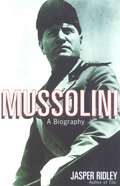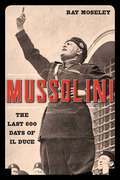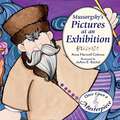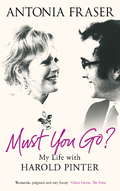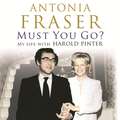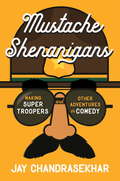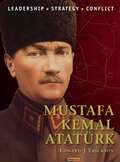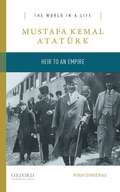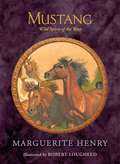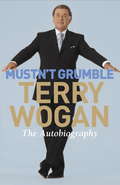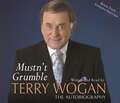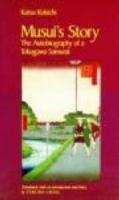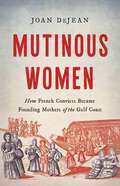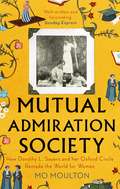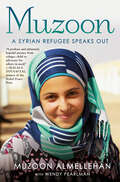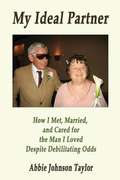- Table View
- List View
Mussolini's Shadow: the Double Life of Count Galeao Ciano
by Ray MoseleyBiography of Mussolini's foreign minister.
Mussolini: A Biography
by Jasper RidleyBenito Mussolini (1883-1945) was the founder of Fascism and iron-fisted ruler of Italy for two decades. He was also an extremely able politician who won the esteem of many statesmen—including Winston Churchill and influential persons in the United States.This biography describes Mussolini's childhood; his education (including his suspension from school for attacking other boys with knives); his World War I experiences and severe wounding; his involvement in, and eventual expulsion from the revolutionary Italian Socialist Party; his numerous love affairs, his early career as a journalist and his rise to power and brutal rule.
Mussolini: The Last 600 Days of Il Duce
by Ray MoseleyIn his last days, Mussolini, the tyrant, was in the grip of anger, shame, and depression. The German armed forces that had sustained his puppet government since its creation in September 1943 were being inexorably driven out of Italy, the frontiers of his Fascist republic were shrinking daily and Mussolini was aware that German military leaders were negotiating with the Allies behind his back in neutral Switzerland. Moseley's well-researched and highly engaging tome throws light on the last twenty months of the despot's life and culminates with the dramatic capture and execution of Mussolini (and his mistress Claretta Petacci) by partisans of the Italian resistance on April 28, 1945.
Mussorgsky's Pictures at an Exhibition (Once Upon a Masterpiece #2)
by Anna Harwell CelenzaWhen his friend Victor suddenly dies, composer Mussorgsky is deeply saddened. But, with the help of his friends, and through his own music, Modest finds a way to keep Victor's spirit alive.Readers of all ages will enjoy the inspirational story behind the composition of Pictures at an Exhibition. Bright, colorful illustrations incorporate elements of Russian folk art and traditional symbols. View pages from artist JoAnn Kitchel's notebook for explanations of the symbols and see her pencil-sketch research of the Russian culture.This handsome book and CD recording provide enrichment for the whole family.
Must You Go?: My Life with Harold Pinter
by Lady Antonia FraserA unique testimony to modern literature's most celebrated and enduring marriage.'I first saw Harold across a crowded room, but it was lunchtime, not some enchanted evening, and we did not speak.'When Antonia Fraser met Harold Pinter she was a celebrated biographer and he was Britain's finest playwright. Both were already married - Pinter to the actress Vivien Merchant and Fraser to the politician Hugh Fraser - but their union seemed inevitable from the moment they met: 'I would have found you somehow', Pinter told Fraser. Their relationship flourished until Pinter's death on Christmas Eve 2008 and was a source of delight and inspiration to them both until the very end. Fraser uses her Diaries and her own recollections to tell a touching love story. But this is also a memoir of a partnership between two of the greatest literary talents, with fascinating glimpses into their creativity and their illustrious circle of friends from the literary, political and theatrical world.
Must You Go?: My Life with Harold Pinter
by Lady Antonia FraserI first saw Harold across a crowded room, but it was lunchtime, not some enchanted evening, and we did not speak...'When Antonia Fraser met Harold Pinter she was a celebrated biographer and he was Britain's finest playwright. Both were already married - Pinter to the actress Vivien Merchant and Fraser to the politician Hugh Fraser - but their union seemed inevitable from the moment they met: 'I would have found you somehow', Pinter told Fraser. Their relationship flourished until Pinter's death on Christmas Eve 2008 and was a source of delight and inspiration to them both until the very end.Fraser uses her Diaries and her own recollections to tell a touching love story. But this is also a memoir of a partnership between two of the greatest literary talents, with fascinating glimpses into their creativity and their illustrious circle of friends from the literary, political and theatrical world.Read by Lindsay Duncan(p) 2010 Orion Publishing Group
Mustache Shenanigans: Making Super Troopers and Other Adventures in Comedy
by Jay ChandrasekharDirector, writer, and actor Jay Chandrasekhar tells the hilarious history of his comedy group, Broken Lizard, and the making of the cult film Super Troopers, as well as the currently filming Super Troopers 2.Jay Chandrasekhar has spent the past two decades writing, directing, and acting in film and TV. With his comedy group, Broken Lizard, he has produced and directed beloved movies such as Super Troopers, Beerfest, and Club Dread. Now, with the upcoming release of the long-awaited Super Troopers 2, Jay is ready to tell the ridiculous, madcap, dead-honest story of how he built his career, how he formed Broken Lizard, and, ultimately, how he made Super Troopers. Jay grew up Indian American in the lily-white suburbs of Chicago, and he had an outsider’s perspective from the beginning. Instead of taking the traditional acting path, he formed his own troupe, wrote his own scripts, and made movies his own way. And he had an incredibly good time doing so as readers will learn in this hilarious story about making it in Hollywood and directing, cowriting, and costarring in one of the best-loved and most-watched comedies of all time. Part humorous memoir, part film study, this book will inform, entertain, and tell readers what drinking multiple bottles of maple syrup is really like.
Mustafa Kemal Atatürk
by Adam Hook Edward EricksonMustafa Kemal was one of the 20th century's greatest combat commanders. Born in Salonika to a middle-class family, this book follows the life of a great commander who served in the Italo-Turkish War of 1911-12 and the Balkan Wars of 1912-13 before taking command of the 19th Division based in Gallipoli during World War l. His sterling service led to his promotion to corps command during the fighting against the Russians in the Caucasus. Following the end of the war he took command of the nationalist forces struggling against the occupation of Turkey, and managed to defeat Greek forces that sought to occupy Smyrna, thus preserving Turkey's territorial integrity. Labelled as the 'Man of Destiny' by Winston Churchill, his services in Gallipoli and the War of Independence were pivotal to the success of his armies. After leading the nationalist army to victory, he established the modern Turkish Republic and became Turkey's first ever president taking the name Atatürk, meaning Father of the Turks, as his own.
Mustafa Kemal Atatürk: Heir to the Empire (The World in a Life Series)
by Ryan Gingeras<p>Part of The World in a Life series, this brief text provides insight into the life of Mustafa Kemal Atatürk. By the outbreak of World War II, the Republic of Turkey epitomized more than a state bound for better times; it aspired to represent the essence of modern politics in the twentieth century. To contemporaries of this period, Mustafa Kemal Atatürk--the country's first president--was both the muse and the architect of this radical transformation. By the time of his death in 1938, he was regularly compared alongside other luminary statesmen of the post-Versailles era. Outside of Turkey, his name was synonymous with bold leadership and ambitious reform. Atatürk's reputation as a man both progressive and iconoclastic greatly augmented his already lofty status as Turkey's premier general and war hero. Yet there were some aspects of his life presidency that tempered contemporary admiration for Mustafa Kemal. His acclaim and celebrity came with the understanding that he was a dictator with little patience for liberal democracy. Atatürk's inability to brook compromise and tolerate opposition engendered acts of violence and oppression that resulted in the deaths of large numbers of his fellow citizens. As a whole, the legacies of both his achievements and flaws as a leader remain critical to any understanding of modern-day Turkey. <p>We live in a global age where big concepts like "globalization" often tempt us to forget the personal side of the past. The titles in The World in a Life series aim to revive these meaningful lives. Each one shows us what it was like to live on a world historical stage. Brief, inexpensive, and thematic, each book can be read in a week, fit within a wide range of curricula, and shed insight into a particular place or time. Four to six short primary sources at the end of each volume sharpen the reader's view of an individual's impact on world history.</p>
Mustang: Wild Spirit of the West (Marguerite Henry Horseshoe Library)
by Marguerite HenryHorses were in Annie Bronn’s blood. For as long as she could remember, she had been fascinated by the spirited wild mustangs that roamed free throughout the West. So when greedy cattlemen started to round up the mustangs for slaughter, Annie knew it was up to her to save the breed. The true story of Wild Horse Annie’s crusade to save the mustangs is inspiring. Readers will cheer her on, all the way to the White House, in her struggle to preserve these beautiful creatures from extinction.
Mustard Seed Faith: A Journey through Infertility, Miscarriages, Adoption, and Faith
by Bethanee SyversenAfter seven miscarriages and three failed adoptions, where do you find the strength to pursue your dream of parenthood?Bethanee Syversen’s deeply personal debut, Mustard Seed Faith: A Journey through Infertility, Miscarriages, Adoption, and Faith, is a story of believing in a God who is powerful enough—and generous enough—to do the impossible.Bethanee always wanted to be a parent. When the doctors gave their prognosis, she had to decide where her strength would come from. She and her husband chose to trust in God. Each negative pregnancy test, each unexpected loss, and each adoption delay would test her heart’s resolve. However, through every blow, Bethanee discovered that God doesn’t give up. He never goes away. And He never leaves His children unrestored. Now a mother of six, Bethanee has experienced the hardship and joy of becoming a mom through birth and through adoption.Much of Mustard Seed Faith comes from Bethanee’s blog, which captured the raw emotion of her story as it unfolded. In part one, Bethanee confronts the heartbreak of infertility and the private grief of multiple miscarriages. In part two, she recounts the physical toll and emotional extremes of adopting. For many, Bethanee’s fourteen-year journey is all too familiar, but it is her uncommon faith in God’s good and sovereign plan that inspires readers to keep hoping, keep praying, and keep believing.
Mustn't Grumble
by Sir Terry Wogan OBETHE SUNDAY TIMES BESTSELLERThe definitive autobiography from the nation's best-loved broadcaster.Written in the style familiar to his millions of listeners, rich with warmth and irony, Mustn't Grumble is Terry's definitive autobiography. Not only does he introduce the reader to his life in Ireland, his chain-smoking maiden aunts, his quick-witted mother and hard-working father and the (not so) Christian Fathers who tried to knock his hands off, he explains how he managed to avoid a hard day's work from childhood to knighthood, and entertained a few million people along the way. Terry talks in full about his past 35 years with the BBC: his hugely popular Radio 2 show, his TV shows Wogan (Now & Then and Blankety Blank, the Eurovision Song Contest, working on the BBC's Children in Need programmes, and where he learnt to breakdance so brilliantly. Mustn't Grumble is fresh, honest and a must-read for any fan of this extraordinary TV and Radio figure.
Mustn't Grumble
by Sir Terry Wogan OBEWritten in a style familiar to his millions of listeners, rich with warmth and irony, MUSTN'T GRUMBLE is Terry's definitive autobiography. Not only does he introduce the reader to post-Emergency Ireland, his chain-smoking maiden aunts, his quick-witted mother and hard-working father and the (not so) Christian Fathers who tried to knock his hands off, he explains how he's managed to avoid a hard day's work from childhood to knighthood, and entertained a few million people along the way. Terry talks in full about his past 35 years with the BBC: his hugely popular Radio 2 show, his TV shows WOGAN (NOW & THEN) and BLANKETY BLANK, the Eurovision Song Contest, working on the BBC's CHILDREN IN NEED programmes, and where he learnt to breakdance so brilliantly. MUSTN'T GRUMBLE is fresh, honest and a real craic.Read by Terry Wogan(p) 2006 Orion Publishing Group
Mustn't Grumble: The Autobiography
by Terry WoganTHE SUNDAY TIMES BESTSELLERThe definitive autobiography from the nation's best-loved broadcaster.Written in the style familiar to his millions of listeners, rich with warmth and irony, Mustn't Grumble is Terry's definitive autobiography. Not only does he introduce the reader to his life in Ireland, his chain-smoking maiden aunts, his quick-witted mother and hard-working father and the (not so) Christian Fathers who tried to knock his hands off, he explains how he managed to avoid a hard day's work from childhood to knighthood, and entertained a few million people along the way. Terry talks in full about his past 35 years with the BBC: his hugely popular Radio 2 show, his TV shows Wogan (Now & Then and Blankety Blank, the Eurovision Song Contest, working on the BBC's Children in Need programmes, and where he learnt to breakdance so brilliantly. Mustn't Grumble is fresh, honest and a must-read for any fan of this extraordinary TV and Radio figure.
Musui's Story: The Autobiography of a Tokugawa Samurai
by Katsu KikichiKatsu Kokichi was a low ranking samurai who lived during the last decades of the Tokugawa period of Japan.
Mutaciones. Autobiografía intelectual
by Roger BartraEstas memorias son el registro del devenir intelectual y personal de Roger Bartra, un atisbo a la conciencia que anima su vida y pensamiento. En esta autobiografía Roger Bartra examina un nudo formado por tres hilos que se extienden a lo largo de su vida intelectual; tres flujos que se mezclan en el pozo profundo de su conciencia. El primero es una obsesión por la verdad que domina su trabajo, a veces de manera estimulante y en ocasiones de forma esclavizadora. El segundo es la permanente sensación de ser extranjero, de ser un extraño enclavado en una sociedad que lo considera ajeno a ella. En tercer lugar, una inclinación por la rebeldía que ha tenido que controlar y domesticar para poder convivir con sus semejantes. Estos flujos, confiesa, le han provocado una permanente sensación de encierro, de estar preso de verdades dogmáticas, de estar en la cárcel de una identidad anómala y de estar poseído por una furia que es necesario mantener atrapada. Pero cuando el nudo se desata, Bartra se siente liberado e impulsado a una búsqueda de verdades frescas y renovadoras, alentado por una rebeldía creativa y estimulante sin estar atado a identidades fija
Muthal Manithan
by Albert Camus V. SriramA Tamil translation of the French autobiographical novel Le premier homme, by Albert Camus that talks about childhood, school days, the life of the body, the power of the sun and the sea, the painful love of a son for his mother, the search for a lost father.
Mutinous Women: How French Convicts Became Founding Mothers of the Gulf Coast
by Joan DeJeanThe secret history of the rebellious Frenchwomen who were exiled to colonial Louisiana and found power in the Mississippi ValleyIn 1719, a ship named La Mutine (the mutinous woman), sailed from the French port of Le Havre, bound for the Mississippi. It was loaded with urgently needed goods for the fledgling French colony, but its principal commodity was a new kind of export: women.Falsely accused of sex crimes, these women were prisoners, shackled in the ship&’s hold. Of the 132 women who were sent this way, only 62 survived. But these women carved out a place for themselves in the colonies that would have been impossible in France, making advantageous marriages and accumulating property. Many were instrumental in the building of New Orleans and in settling Louisiana, Alabama, Arkansas, Illinois, and Mississippi.Drawing on an impressive range of sources to restore the voices of these women to the historical record, Mutinous Women introduces us to the Gulf South&’s Founding Mothers.
Mutual Admiration Society: How Dorothy L. Sayers and Her Oxford Circle Remade the World For Women
by Mo Moulton'An enjoyable anthem to friendship' Hephzibah Anderson, Observer'Hugely enjoyable . . . Modern-day readers can thank the ambitious, complicated, funny, brave women of the Mutual Admiration Society' Anna Carey, Sunday Business Post'A tribute to that precious but still unsung thing: the loving bond between female friends, based on intellectual exchange and deep affection' Charlotte Higgins, Guardian Winner of the Agatha Award for best nonfiction 2020Dorothy L. Sayers is now famous for her Lord Peter Wimsey and Harriet Vane detective series, but she was equally well known during her life for an essay asking 'Are Women Human?' Women's rights were expanding rapidly during Sayers's lifetime; she and her friends were some of the first women to receive degrees from Oxford. Yet, as historian Mo Moulton reveals, it was clear from the many professional and personal obstacles they faced that society was not ready to concede that women were indeed fully human. Dubbing themselves the Mutual Admiration Society, Sayers and her classmates remained lifelong friends and collaborators as they fought for a truly democratic culture that acknowledged their equal humanity. A celebration of feminism and female friendship, Mutual Admiration Society offers crucial insight into Dorothy L. Sayers and her world.
Muzoon: A Syrian Refugee Speaks Out
by Wendy Pearlman Muzoon AlmellehanWhen her family had to flee Syria, 14-year-old Muzoon was told to pack only the most essential things—and so she packed her schoolbooks. <p><p> This is the inspiring true story of a Syrian refugee who fought hard for what she needed—and grew into one of the world’s leading advocates for education. <p><p> This eye-opening memoir tells the story of a young girl’s life in Syria, her family’s wrenching decision to leave their home, and the upheaval of life in a refugee camp. Though her life had utterly changed, one thing remained the same. She knew that education was the key to a better future—for herself, and so that she could help her country. She went from tent to tent in the camp, trying to convince other kids, especially girls, to come to school. And her passion and dedication soon had people calling her the “Malala of Syria.” <p><p>Muzoon has grown into an internationally recognized advocate for refugees, for education, and for the rights of girls and women, and is now a UNICEF goodwill ambassador—the first refugee to play that role. <p><p>Muzoon’s story is absolutely riveting and will inspire young readers to use their own voices and stand up for what they believe in.
My Ideal Partner: How I Met, Married, and Cared for The Man I Loved Despite Debilitating Odds
by Abbie Johnson TaylorIn September of 2005, Abbie Johnson married Bill Taylor. She was in her mid-forties, and he was nineteen years older. Three months later, Bill suffered the first of two strokes that paralyzed his left side and confined him to a wheelchair. Abbie Johnson Taylor, once a registered music therapist, uses prose and poetry to tell the story of how she met and married her husband, then cared for him for six years despite her visual impairment. At first, there was a glimmer of hope that Bill would walk again, but when therapists gave up on him seven months after his second stroke, Taylor resigned herself to being a permanent family caregiver. She discusses learning to dress him and transfer him from one place to another, sitting up with him at night when he couldn't urinate or move his bowels, and dealing with doctors and bureaucrats to obtain necessary equipment and services. There were happy times, like when she played the piano or guitar and sang his favorite songs, or when they went out to eat or to a concert. She also explains how she purchased a wheelchair accessible van and found people to drive it, so they wouldn't always depend on the local paratransit service's limited hours. In the end, she describes the painful decision she and Bill made to move him to a nursing home when he became too weak for her to care for him in September of 2012. He seemed to give up on life and passed away a month later. Abbie Johnson Taylor lives in Sheridan, Wyoming and is the author of three previously published books.
My (Half) Latinx Kitchen: Half Recipes, Half Stories, All Latin American
by Kiera Wright-Ruiz“Kiera Wright-Ruiz's My (Half) Latinx Kitchen is entirely singular: hilarious and poignant in its stories, precise and flavorful in its recipes, the book is a gem of memory and feeling for where you've been, where you're going, and how you find yourself in between.” -Bryan Washington, author of Family Meal and MemorialYou’re invited on this culinary journey of self-discovery as Kiera Wright-Ruiz connects to her Latinx roots with recipes and stories from the diaspora.“What are you?” is a dreaded question that has followed Kiera Wright-Ruiz around her entire life. She is half Latinx and half Asian, and her journey to understand her identity has been far from linear. Though she is a first-generation American, she didn’t grow up in a home where many traditions from her family’s home countries were passed down by her parents. Kiera’s childhood was complicated, and the role of caregiver was played by various people in her life: from her mom and dad to her grandparents and foster parents. Many of whom were from all different parts of Latin America, and each of them taught Kiera something about what it means to be Latinx through their food.This cookbook is the story of Kiera’s journey to embrace her identity and all her cultures: Latinx, Asian, and American. It’s a celebration of Latin American food in all its vibrant, flavorful glory, and a love letter to the diaspora. From Ecuador to South Florida, Mexico to Cuba, the recipes in this book are as diverse and unique as the cultures themselves with dishes like:Ecuadorian Seco de Pollo (one of the most beloved dishes from her father’s home country)Three Salsas to Know Before You DiePeruvian Ceviche with Leche de Tigre (her aunt’s iconic recipe)Elote TaquitosPernil (a traditionally Puerto Rican dish that is now her family’s Thanksgiving main course)Lomo SaltadoTamarindoOkonomiyaki QuesadillasPandan Coconut FlanMexican Hot Chocolate CookiesKiera also weaves in charming personal essays to accompany the recipes—from the story of how tamale soup helped bring her family together again after being separated in foster care, to their tradition of bringing visiting relatives from Mexico to what she considers the most American place: Medieval Times.This one-of-a-kind cookbook featuring 100 inventive recipes shows how being half can ultimately lead to being whole. It will inspire you in the kitchen and expose you to a different kind of first-generation story, one that’s never been told before.
My (Part-Time) Paris Life: How Running Away Brought Me Home
by Lisa AnselmoPoignant, touching, and lively, this memoir of a woman who loses her mother and creates a new life for herself in Paris will speak to anyone who has lost a parent or reinvented themselves. Lisa Anselmo wrapped her entire life around her mother, a strong woman who was a defining force in her daughter’s life—maybe too defining. When her mother dies from breast cancer, Lisa realizes she hadn’t built a life of her own, and struggles to find her purpose. Who is she without her mother—and her mother’s expectations? Desperate for answers, she reaches for a lifeline in the form of an apartment in Paris, refusing to play it safe for the first time. What starts out as a lurching act of survival sets Lisa on a course that reshapes her life in ways she never could have imagined. But how can you imagine a life bigger than anything you’ve ever known? In the vein of Eat, Pray, Love and Wild, My (Part-time) Paris Life a story is for anyone who’s ever felt lost or hopeless, but still holds out hope of something more. This candid memoir explores one woman’s search for peace and meaning, and how the ups and downs of expat life in Paris taught her to let go of fear, find self-worth, and create real, lasting happiness.
My (Underground) American Dream: My True Story as an Undocumented Immigrant Who Became a Wall Street Executive
by Julissa ArceWhat does an undocumented immigrant look like? What kind of family must she come from? How could she get into this country? What is the true price she must pay to remain in the United States? JULISSA ARCE knows firsthand that the most common, preconceived answers to those questions are sometimes far too simple-and often just plain wrong. On the surface, Arce's story reads like a how-to manual for achieving the American dream: growing up in an apartment on the outskirts of San Antonio, she worked tirelessly, achieved academic excellence, and landed a coveted job on Wall Street, complete with a six-figure salary. The level of professional and financial success that she achieved was the very definition of the American dream. But in this brave new memoir, Arce digs deep to reveal the physical, financial, and emotional costs of the stunning secret that she, like many other high-achieving, successful individuals in the United States, had been forced to keep not only from her bosses, but even from her closest friends. From the time she was brought to this country by her hardworking parents as a child, Arce-the scholarship winner, the honors college graduate, the young woman who climbed the ladder to become a vice president at Goldman Sachs-had secretly lived as an undocumented immigrant. In this surprising, at times heart-wrenching, but always inspirational personal story of struggle, grief, and ultimate redemption, Arce takes readers deep into the little-understood world of a generation of undocumented immigrants in the United States today- people who live next door, sit in your classrooms, work in the same office, and may very well be your boss. By opening up about the story of her successes, her heartbreaks, and her long-fought journey to emerge from the shadows and become an American citizen, Arce shows us the true cost of achieving the American dream-from the perspective of a woman who had to scale unseen and unimaginable walls to get there.

